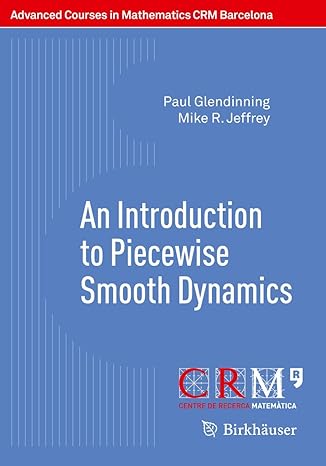
- Author: Paul Glendinning and Mike R. Jeffrey
- Series: Advanced Courses in Mathematics - CRM Barcelona
- Publisher: Springer
- Publication Date: 10/21/2019
- Number of Pages: 129
- Format: Electronic Book
- Price: $29.99
- ISBN: 978-3-030-23689-2
- Category: textbook
[Reviewed by Bill Satzer , on 12/02/2024]
The study of piecewise smooth dynamics incorporates both theory and applications of those dynamical systems, smooth almost everywhere, which encounter discontinuities in isolated places, usually at some kind of threshold condition. The authors present an informal graduate course for studying models that involve such a discontinuity.
The material provided here is derived from presentations given at a 2016 conference on this general subject. A related book by the second author (Modeling with Nonsmooth Dynamics, reviewed here) provides a short introductory tutorial on the same subject. The current book has two parts with the first author discussing piecewise-smooth maps (with discrete time), and the second author taking up piecewise-smooth flows (with continuous time).
Engineers, as one of the authors notes, have been dealing with systems that contain jumps for many years, but the dynamical systems community over the same period has concentrated almost exclusively on smooth dynamical systems. Systems with jumps – present in many real physical, chemical, and biological systems – can be messy. Piecewise-smooth differential equations can, for example, fail to have unique solutions.
The discussion of flows in this context begins by looking back to the history of how discontinuities in mechanics and control systems were handled, including development of a theory of differential equations with discontinuous right-hand sides. Most of the treatment of piecewise-linear flows focuses on how to get a well-defined flow from a discontinuous vector field. Such a vector field is discontinuous at a switching surface, and a sliding vector field can be induced on this surface. Solutions can cross the sliding surface or slide along it in one or more modes.
The discussion for piecewise linear maps has a different character. The phase space is partitioned into distinct open regions whose union is the whole space. A piecewise smooth map is a map on each partition, defined by a different smooth function in each region. Because the system proceeds in discrete steps there is essentially no chance of encountering the discontinuity itself. The treatment begins with examples and one-dimensional maps, moves to two-dimensions, and briefly touches on higher dimensions.
For both flows and maps, the phenomena seen in smooth dynamics (bifurcation, periodicity, attractors, and stability issues) are still present, but different approaches are needed for their analysis. For example, a hidden attractor can occur in the switching surface of a piecewise-linear flow.
The discussions in this book implicitly assume a moderately sophisticated audience. Consequently, the text cited earlier is probably more appropriate for those new to the subject.
Bill Satzer (bsatzer@gmail.com), now retired from 3M Company, spent most of his career as a mathematician working in industry on a variety of applications. He did his PhD work in dynamical systems and celestial mechanics.
